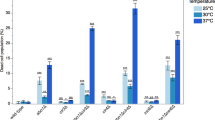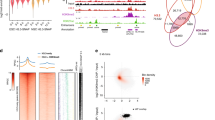Abstract
In contrast to stably repressive, constitutive heterochromatin and stably active, euchromatin, facultative heterochromatin has the capacity to alternate between repressive and activated states of transcription1. As such, it is an instructive source to understand the molecular basis for changes in chromatin structure that correlate with transcriptional status. Sirtuin 1 (SIRT1) and suppressor of variegation 3–9 homologue 1 (SUV39H1) are amongst the enzymes responsible for chromatin modulations associated with facultative heterochromatin formation. SUV39H1 is the principal enzyme responsible for the accumulation of histone H3 containing a tri-methyl group at its lysine 9 position (H3K9me3) in regions of heterochromatin2. SIRT1 is an NAD+-dependent deacetylase that targets histone H4 at lysine 16 (refs 3 and 4), and through an unknown mechanism facilitates increased levels of H3K9me3 (ref. 3). Here we show that the mammalian histone methyltransferase SUV39H1 is itself targeted by the histone deacetylase SIRT1 and that SUV39H1 activity is regulated by acetylation at lysine residue 266 in its catalytic SET domain. SIRT1 interacts directly with, recruits and deacetylates SUV39H1, and these activities independently contribute to elevated levels of SUV39H1 activity resulting in increased levels of the H3K9me3 modification. Loss of SIRT1 greatly affects SUV39H1-dependent H3K9me3 and impairs localization of heterochromatin protein 1. These findings demonstrate a functional link between the heterochromatin-related histone methyltransferase SUV39H1 and the histone deacetylase SIRT1.
This is a preview of subscription content, access via your institution
Access options
Subscribe to this journal
Receive 51 print issues and online access
$199.00 per year
only $3.90 per issue
Buy this article
- Purchase on Springer Link
- Instant access to full article PDF
Prices may be subject to local taxes which are calculated during checkout




Similar content being viewed by others
References
Craig, J. M. Heterochromatin—many flavours, common themes. Bioessays 27, 17–28 (2005)
Rea, S. et al. Regulation of chromatin structure by site-specific histone H3 methyltransferases. Nature 406, 593–599 (2000)
Vaquero, A. et al. Human SirT1 interacts with histone H1 and promotes formation of facultative heterochromatin. Mol. Cell 16, 93–105 (2004)
Imai, S., Armstrong, C. M., Kaeberlein, M. & Guarente, L. Transcriptional silencing and longevity protein Sir2 is an NAD-dependent histone deacetylase. Nature 403, 795–800 (2000)
Tachibana, M. et al. G9a histone methyltransferase plays a dominant role in euchromatic histone H3 lysine 9 methylation and is essential for early embryogenesis. Genes Dev. 16, 1779–1791 (2002)
Shankaranarayana, G. D., Motamedi, M. R., Moazed, D. & Grewal, S. I. Sir2 regulates histone H3 lysine 9 methylation and heterochromatin assembly in fission yeast. Curr. Biol. 13, 1240–1246 (2003)
Sewalt, R. G. et al. Selective interactions between vertebrate polycomb homologs and the SUV39H1 histone lysine methyltransferase suggest that histone H3–K9 methylation contributes to chromosomal targeting of Polycomb group proteins. Mol. Cell. Biol. 22, 5539–5553 (2002)
Sauve, A. A., Wolberger, C., Schramm, V. L. & Boeke, J. D. The biochemistry of sirtuins. Annu. Rev. Biochem. 75, 435–465 (2006)
Monneret, C. Histone deacetylase inhibitors. Eur. J. Med. Chem. 40, 1–13 (2005)
Bitterman, K. J., Anderson, R. M., Cohen, H. Y., Latorre-Esteves, M. & Sinclair, D. A. Inhibition of silencing and accelerated aging by nicotinamide, a putative negative regulator of yeast Sir2 and human SIRT1. J. Biol. Chem. 277, 45099–45107 (2002)
Min, J., Zhang, X., Cheng, X., Grewal S. I & Xu, R. M. Structure of the SET domain histone lysine methyltransferase Clr4. Nature Struct. Biol. 9, 828–832 (2002)
Melcher, M. et al. Structure–function analysis of SUV39H1 reveals a dominant role in heterochromatin organization, chromosome segregation, and mitotic progression. Mol. Cell. Biol. 20, 3728–3741 (2000)
Vaquero, A. et al. SirT2 is a histone deacetylase with preference for histone H4 Lys 16 during mitosis. Genes Dev. 20, 1256–1261 (2006)
Winkler, G. S. et al. Isolation and mass spectrometry of transcription factor complexes. Methods 26, 260–269 (2002)
Nishioka, K. et al. PR-Set7 is a nucleosome-specific methyltransferase that modifies lysine 20 of histone H4 and is associated with silent chromatin. Mol. Cell 9, 1201–1213 (2002)
Peters, A. H. et al. Loss of the Suv39h histone methyltransferases impairs mammalian heterochromatin and genome stability. Cell 107, 323–337 (2001)
Cheng, H. L. et al. Developmental defects and p53 hyperacetylation in Sir2 homolog (SIRT1)-deficient mice. Proc. Natl Acad. Sci. USA. 100, 10794–10799 (2003)
Acknowledgements
We thank T. Jenuwein for sharing expression plasmids for wild-type and mutant versions of SUV39H1 and SUV39H1 MEF cells (wild type and -/-); F. W. Alt for SIRT1 MEF cells (wild type and -/-); P. Trojer and other members of the Reinberg laboratory for discussions; L. Vales for comments on the manuscript; K. Cabane for technical assistance; and L. Lacomis for help with mass spectrometric analysis. This work was supported by the NIH and HHMI (D.R.) and the NCI Cancer Center (P.T.).
Author information
Authors and Affiliations
Corresponding author
Ethics declarations
Competing interests
The authors declare no competing financial interests.
Supplementary information
Supplementary Information
The file contains Supplementary Figures S1-S6 with legends and additional references. (PDF 1647 kb)
Rights and permissions
About this article
Cite this article
Vaquero, A., Scher, M., Erdjument-Bromage, H. et al. SIRT1 regulates the histone methyl-transferase SUV39H1 during heterochromatin formation. Nature 450, 440–444 (2007). https://doi.org/10.1038/nature06268
Received:
Accepted:
Published:
Issue Date:
DOI: https://doi.org/10.1038/nature06268
This article is cited by
-
Genetic determinants of micronucleus formation in vivo
Nature (2024)
-
SIRT1 safeguards adipogenic differentiation by orchestrating anti-oxidative responses and suppressing cellular senescence
GeroScience (2023)
-
Targeting the histone H3 lysine 79 methyltransferase DOT1L in MLL-rearranged leukemias
Journal of Hematology & Oncology (2022)
-
Establishment of H3K9-methylated heterochromatin and its functions in tissue differentiation and maintenance
Nature Reviews Molecular Cell Biology (2022)
-
HDAC6 regulates primordial follicle activation through mTOR signaling pathway
Cell Death & Disease (2021)
Comments
By submitting a comment you agree to abide by our Terms and Community Guidelines. If you find something abusive or that does not comply with our terms or guidelines please flag it as inappropriate.



